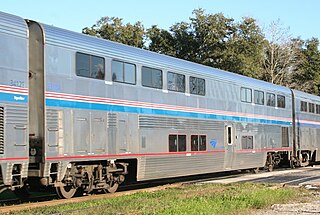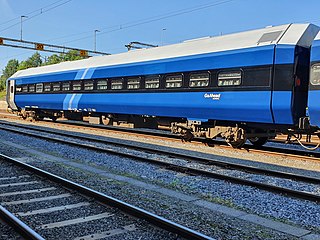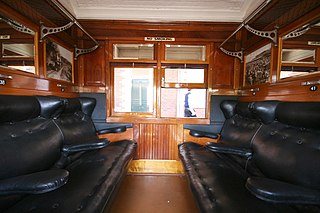
First class is the most luxurious and most expensive travel class of seats and service on a train, passenger ship, airplane, bus, or other system of transport. Compared to business class and economy class, it offers the best service and most comfortable accommodation.

A passenger railroad car or passenger car, also called a passenger carriage, passenger coach, or passenger bogie is a railroad car that is designed to carry passengers. The term passenger car can also be associated with a sleeping car, a baggage car, a dining car, railway post office and prisoner transport cars.
A royal train is a set of railway carriages dedicated for the use of the monarch or other members of a royal family. Most monarchies with a railway system employ a set of royal carriages.
There are three basic types of Norwegian railway carriage used commonly by NSB on the Norwegian railway system, the Class 3, Class 5 and Class 7 series. As of 2005, the carriages are hauled by NSB El 18 engines on the main electrified stretches and NSB Di 4 engines on non-electrified lines.

The Venice Simplon-Orient-Express (VSOE) is a private luxury train service from London to Venice and other European cities. It is currently owned by Belmond.

The Eastern & Oriental Express is a luxury cruise train that carries passengers between Singapore, Malaysia, and Thailand.

A horse trailer or horse van is used to transport horses. There are many different designs, ranging in size from small units capable of holding two or three horses, able to be pulled by a pickup truck or SUV; to gooseneck designs that carry six to eight horses, usually pulled by 1-ton dually-style pickups. There are also large semi-trailers that can haul a significant number of animals. In the UK, a horsebox may also refer to a motorised vehicle adapted to carry horses, or a railway vehicle specifically designed to carry horses.

The British Royal Train is used to convey senior members of the British royal family and associated staff of the Royal Household around the railway network of Great Britain. It is owned, maintained and operated by DB Cargo UK.

The S type carriages are a corridor-type passenger carriage used on the railways of Victoria, Australia. The first carriages were constructed by the Victorian Railways in 1937 for use on the Spirit of Progress, with additional carriages built for other trains until the mid-1950s.

The W type carriages were wooden passenger carriages used on the railways of Victoria, Australia. There were two variants, short- and long-body vehicles, and this article deals with the former. Details on the latter can be found here.

The Victorian Railways' (VR) Royal Trains operated to transport members of the royal family on their numerous tours of Australia on the Victorian rail network. The same carriages were also used for a number of vice-regal trains for the governor-general of Australia and the governor of Victoria. The last Royal Train ran in 1988.
The V type carriages, introduced from 1897, were the first group of Victorian Railways passenger rolling stock to have their own distinct class.

The Maharajas' Express is a luxury tourist train owned and operated by The Indian Railway Catering and Tourism Corporation (IRCTC). It serves four routes across North-West and Central India, mainly centered on Rajasthan between the months of October and April.
The New South Wales stainless steel carriage stock was a type of passenger carriage operated by the New South Wales Government Railways from 1961 until 1993.
This article is intended as a catalogue of sleeping carriages used by the Victorian Railways and successors.

NSB WLAB-2 or WLAB2 is a class of twenty sleeping cars built by Strømmens Verksted for the Norwegian State Railways (NSB). They serve as the sole sleepers in Norway, being used on the Bergen Line, Dovre Line, Nordland Line and Sørlandet Line. Each car features fifteen compartments, which can each be utilized with a single or twin bunk configuration. The carriages have a unique octagonal shape, are 27 meters long and weigh 48 tonnes.
This page outlines the history and evolution of Victorian Railways (Australia) bogie passenger carriages, constructed with steel underframes and timber bodies up to 59 ft 9 in (18.21 m) long, as well as a few other carriages from the era.

V&SAR Intercolonial Express Carriages were carriages on a new train called the Intercolonial Express running on Victorian Railways and South Australian Railways in 1887. The track of two railways met on Wednesday 19 January 1887. The Victorian Railways' Western Line to Dimboola, and the South Australian Railways' Wolseley line, met at Serviceton. Since both sides shared the broad gauge of 5'3", an agreement was made between the two railways allowing a pool of carriages, classed O, to be specifically allocated to interstate trains linking the capitals of Melbourne and Adelaide. The operating and maintenance cost of the new train would be funded by both railways, approximately 60% paid for by the Victorian Railways and 40% by the South Australian Railways.

The E type carriages were wooden express passenger carriage used on the railways of Victoria, Australia. Originally introduced by Victorian Railways Chairman of Commissioners Thomas James Tait for the interstate service between Melbourne, Sydney and Adelaide, these Canadian-inspired carriages remained in regular service for 85 years over the entire Victorian network.
The Railways Act, 1989 is an Act of the Parliament of India which regulates all aspects of rail transport. The Act came into force in 1989, replacing the Railways Act of 1890. The Act provides in detail the legislative provisions regarding railway zones, construction and maintenance of works, passenger and employee services.













